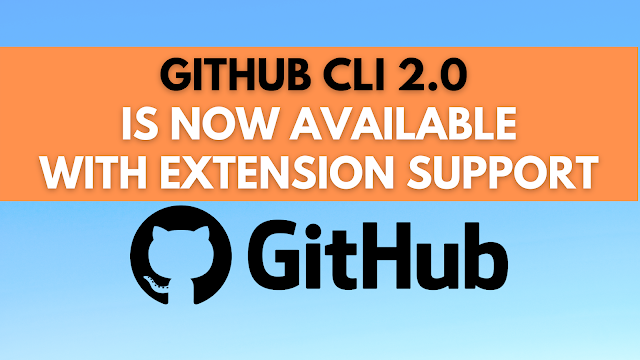Extensions are included in the most recent major release of GitHub's command-line tool. This strong feature extends the capabilities of gh.
The GitHub CLI tool extends GitHub's functionality to your terminal. It's become one of the most popular command-line tools for developers all around the world since its introduction in September of last year.
GitHub is back with its second major revision of the GitHub CLI, over a year later. What's new in this version, and why should you be excited? Let's have a look.
Welcome, Extensions
The support for extensions is perhaps the most significant inclusion in this version. Git repositories with a single executable file are known as these extensions. This script extends the CLI's capabilities by allowing you to perform custom commands.
This move should result in a slew of open-source extensions that improve the development experience even more. Don't know where to begin? For you to test out, the GitHub team has compiled a list of extensions. Here are a few prominent examples:
New features
Support for command extensions
GitHub CLI extensions are additional gh commands that you can install from other repositories. For example:
$ gh extension install owner/gh-my-extension
# invoke the new command
$ gh my-extension
Other additions
Display label colors in
issue listoutput #4106Add
--templatehelper functions for rendering data into tables #3519Add
GH_FORCE_TTYto enable terminal-style output even when redirected #4146Add
pr checkout --branchflag to control the branch name #4005Add
release create --discussion-categoryflag #4003Add
gh config set browseroption andGH_BROWSERenvironment variable #3992Add
gh repo list --topicfilter #4136Add PowerShell instructions to
completionhelp #4114
Fixes
Improve accessibility of interactive select menus #4172
Improve detection of truecolor terminal capabilities #4106
Avoid wrapping issues in powershell.exe #4106
Detect missing git and abort early during
auth loginflow #4109Fix HTTP 502 error printing from GraphQL responses #4154
Removals
The Essential Characteristics Remain
While extensions are entertaining to experiment with, the GitHub CLI's fundamental functionality remains unchanged. Cloning repositories, generating pull requests, and creating gists are all still available from the terminal, so you can manage your GitHub workflow without leaving it.
Right From Your Terminal, Unlock the Power of GitHub
With tools like GitHub CLI, GitHub is making the life of developers simpler. Another fantastic innovation by GitHub this year has been the release of GitHub Copilot. Copilot is a pair programming AI that has the potential to change the way you write code.
Would you want to learn more about this coding AI? Here's a quick rundown of how it works and what you can do with it as a developer.
Posts You May like:
- Capture local Real-Time Air Quality Data with Raspberry Pi Pico
- Connecting Wi-Fi on Raspberry Pi Pico Become Easy
- How To Track All Devices with Raspberry Pi
- Make your own Raspberry Pi Image from scratch
- How to Send phone notifications Using Raspberry Pi Pico?
- Raspberry Pi Pico 4G/2G Expansion : Expectations vs. Reality
- Quick Example to Drive Servo Using Programmable I/O
- How to Use a USB SSD or Flash Drive to Boot a Raspberry Pi 4 / Pi 400
- Filter Ads by your Raspberry Pi Before they Reach your Devices
- A Raspberry Pi 4 Model A Launch 2022 - Eben Upton
- First-Ever 2G Expansion Board for Raspberry Pi Pico has Launched on Kickstarter
- Learn IoT "Internet of Things" with 24 lessons for Teachers and Students
- Quick Guide for Raspberry Pi Users: Raspberry Pi Terminal Commands
- Windows 11 on Raspberry Pi Devices in Easy Installation Guide
- Get Your Project Done by Raspberry Pi Approved Design Partners
- PiRelay 8 Smart Relay Board for Raspberry Pi - Kickstarter
- Tiny Round/Circular LCD Display Launched!
- Issue Fixed! USB Boot Ubuntu Server 20.04 on Raspberry Pi 4
- HC-SR04 Sensor with micro-ROS on the Raspberry Pi Pico
- Raspberry Pi Pico: ADC Sampling and FFT
- Using CircuitPython for RP2040
- How to Setup Pico RP2040 on Windows
- Using micro-ROS on the Raspberry Pi Pico
- LED Tricks Using The Raspberry Pi Pico
- The RP2040 Raspberry Pi Pico Meets LoRa
- Pico supports SD cards and FatFS
- How to connect a Raspberry Pi Pico to LoRaWAN
- 50 Raspberry Pi Hacks & Tips You Should Know
- How to Install Wi-Fi and Internet on a Raspberry Pi Pico
















.png)




